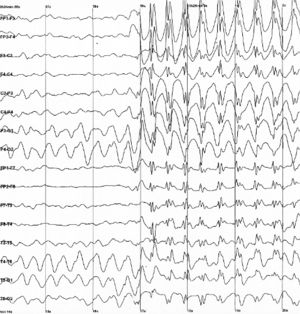Generalized epilepsy
| Generalized epilepsy | |
|---|---|
 | |
| Generalized 3 Hz spike-and-wave discharges on an electroencephalogram | |
| Classification and external resources | |
| Specialty | neurology |
| ICD-10 | G40.3 |
| ICD-9-CM | 345.0-345.1 |
| MeSH | D004829 |
Generalized epilepsy, also known as primary generalized epilepsy or idiopathic epilepsy, is a form of epilepsy characterised by generalised seizures with no apparent cause.[1] Generalized seizures, as opposed to focal seizures, are a type of seizure that impairs consciousness and distorts the electrical activity of the whole or a larger portion of the brain (which can be seen, for example, on electroencephalography, EEG).[2]
Generalized epilepsy is primary because the epilepsy is the originally diagnosed condition itself, as opposed to secondary epilepsy, which occurs as a symptom of a diagnosed condition.[3]
Manifestation
Generalized seizures can be either absence seizures, myoclonic seizures, clonic seizures, tonic-clonic seizures or atonic seizures.
Generalized seizures occur in various seizure syndromes, including myoclonic epilepsy, familial neonatal convulsions, childhood absence epilepsy, absence epilepsy, infantile spasms (West's syndrome), Juvenile Myoclonic Epilepsy and Lennox-Gastaut syndrome.
Prognosis
Most generalized epilepsy starts during childhood. While some patients outgrow their epilepsy during adolescence and no longer need medication, in others, the condition remains for life, thereby requiring lifelong medication and monitoring.
Treatment
Seven anti-epileptic drugs are approved for use in cases of suspected primary generalized epilepsy:
- Brand Name: Felbatol Generic Name: Felbamate [4]
- Levetiracetam
- Zonisamide
- Topiramate
- Valproate
- Lamotrigine
- Perampanel
Valproate, a relatively old drug, is often considered the first-line treatment. It is highly effective, but its association with fetal malformations when taken in pregnancy limits its use in young women.[5]
All anti-epileptic drugs (including the above) can be used in cases of partial seizures.
References
- ↑ "Comprehensive Epilepsy Center | NYU Langone Medical Center". Med.nyu.edu. Retrieved 2016-12-16.
- ↑ "Primary Generalized Epilepsy". Nervous-system-diseases.com. 2013-09-09. Retrieved 2016-12-16.
- ↑ "Seizures or epilepsy". Pediatricservices.com. 2013-01-26. Retrieved 2016-12-16.
- ↑ Personal Use
- ↑ Vajda, FJ; O'brien, TJ; Hitchcock, A; Graham, J; Cook, M; Lander, C; Eadie, MJ (November 2004). "Critical relationship between sodium valproate dose and human teratogenicity: results of the Australian register of anti-epileptic drugs in pregnancy". Journal of Clinical Neuroscience. 11 (8): 854–8. doi:10.1016/j.jocn.2004.05.003. PMID 15519862.
Template:Epilepsy types